How to Implement Lean in Telecommunications: A Guide to Streamlined Operations

In an industry defined by high competition, complex infrastructure, and rapidly evolving technologies, telecom organizations are under constant pressure to do more with less. From managing large-scale network rollouts to meeting ever-growing customer expectations, every inefficiency adds up. That’s why more telecom providers are embracing lean principles—not just to cut costs, but to build agile, responsive operations that scale.
But what does lean truly look like in a telecom environment? How do concepts developed in manufacturing translate to service-driven, tech-heavy workflows?
In this article, we’ll break down the fundamentals of Lean thinking, explore how it applies to various telecom functions, and show how tools support its implementation at scale.
Understanding Lean Principles In Telecommunications
The telecommunications industry, known for its rapid innovation and high operational costs, has increasingly turned to lean principles to drive efficiency, reduce waste, and improve customer experience. Originally developed in manufacturing, lean emphasizes creating more value for customers with fewer resources. When applied in telecommunications, it enables organizations to streamline processes, enhance service delivery, and remain competitive in a saturated market.
Why Lean Matters In Telecom
Telecom providers manage complex infrastructures, large customer bases, and fast-changing technologies. This often leads to inefficiencies—siloed departments, redundant workflows, and long delivery cycles. Lean principles help combat these challenges by:
- Identifying and eliminating non-value-added activities
- Improving response time to customer demands
- Fostering a culture of continuous improvement
For decision-makers in software-powered telecom enterprises, adopting lean is not just an option—it’s a necessity to scale sustainably.
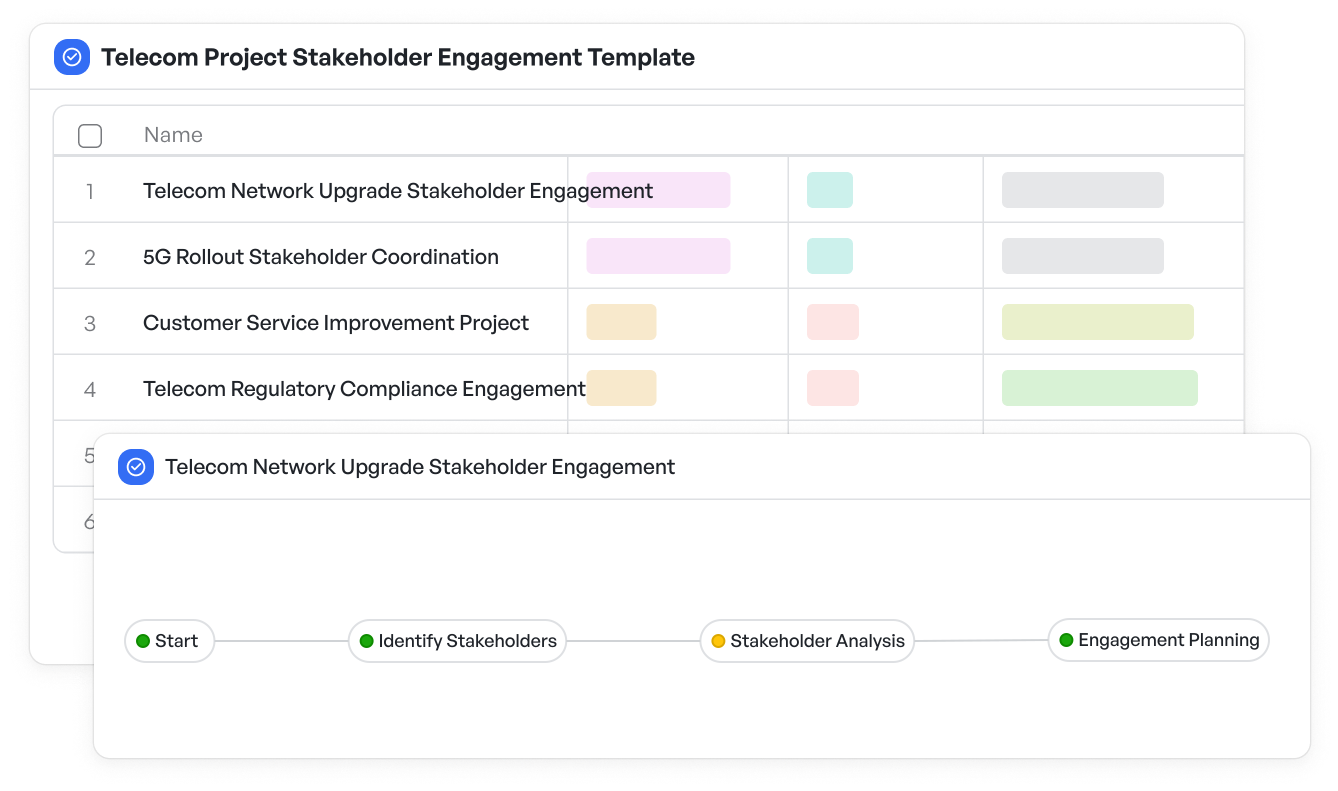 Use the stakeholder engagement template to align departments and reduce delays caused by siloed communication.
Use the stakeholder engagement template to align departments and reduce delays caused by siloed communication.Origins And Adaptation Of Lean
Lean’s roots lie in the Toyota Production System. Over time, its focus on efficiency, standardization, and continuous improvement made it relevant to sectors far beyond manufacturing. In telecom, lean is often combined with Agile and DevOps methodologies to optimize both customer-facing and internal processes.
Key Lean Concepts Applied To Telecommunications
Value Stream Mapping (Vsm):
Telecom organizations can use value stream mapping to visualize every step in service provisioning—from order capture to final activation. It helps identify delays, handoff gaps, and unnecessary approvals that hinder service delivery.
Pro tip: Leverage proven workflow strategies to map out telecom service delivery in real-time by helping you pinpoint delays, redundancies, and improvement opportunities.
Flow Efficiency:
Flow refers to the smooth progression of a task from start to finish. In telecom, ensuring uninterrupted flow across teams (e.g., provisioning, engineering, customer support) significantly reduces lead times.
Pull Systems:
Instead of pushing tasks into teams' queues, a pull system ensures that work is taken on only when there is capacity—preventing overload and improving output quality.
Kaizen (Continuous Improvement):
Kaizen in telecom often takes the form of postmortems after incidents, feedback loops in project management, and incremental updates to internal processes. The goal is small, ongoing improvements that compound over time.
Practical Applications Of Lean In Telecom
Network Infrastructure Management
Lean reduces waste in network planning, deployment, and maintenance. Automated workflows and transparent task ownership ensure that network upgrades or issue resolutions are managed proactively and collaboratively.
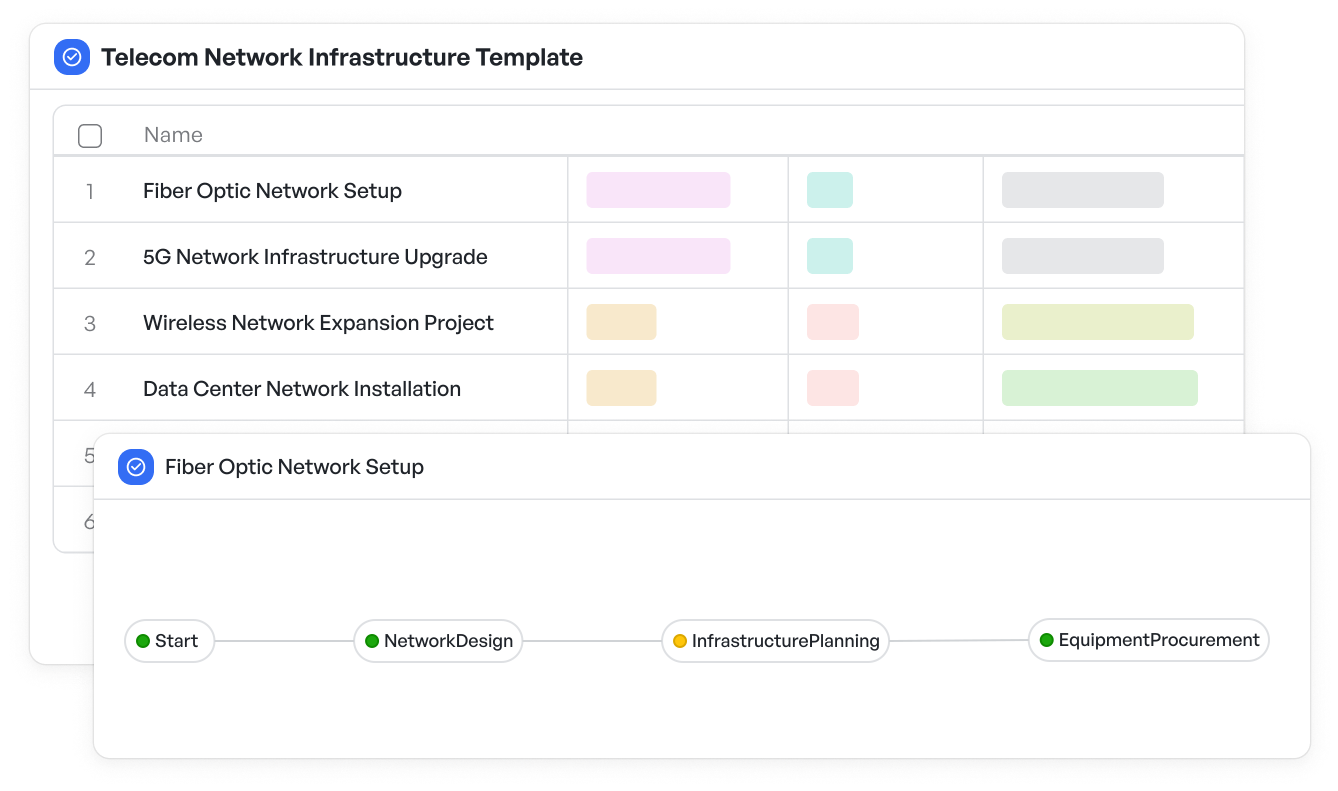 Meegle's Telecom network infrastructure template
Meegle's Telecom network infrastructure templateNetwork Operations
Lean helps reduce waste in network planning, deployment, and maintenance. Clear ownership, streamlined workflows, and visibility into task progress lead to faster resolution and rollout.
Customer Onboarding
With lean, telecom firms can refine customer onboarding journeys by removing redundant steps, shortening wait times, and improving cross-functional coordination between sales, provisioning, and support.
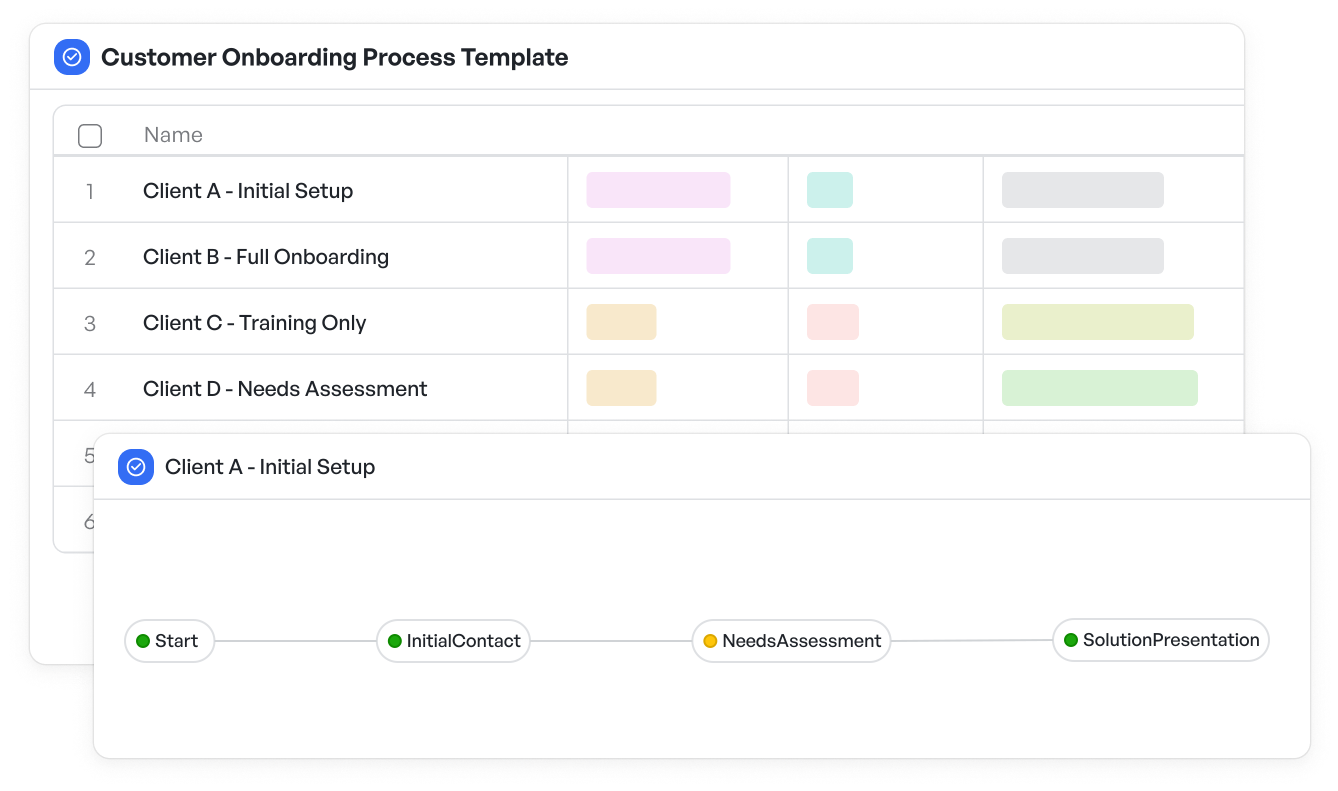 You might be interested in: Customer onboarding template
You might be interested in: Customer onboarding templateSoftware And Internal Projects
Telecom companies managing billing systems, customer portals, or analytics platforms can apply lean project management to improve delivery speed and transparency.
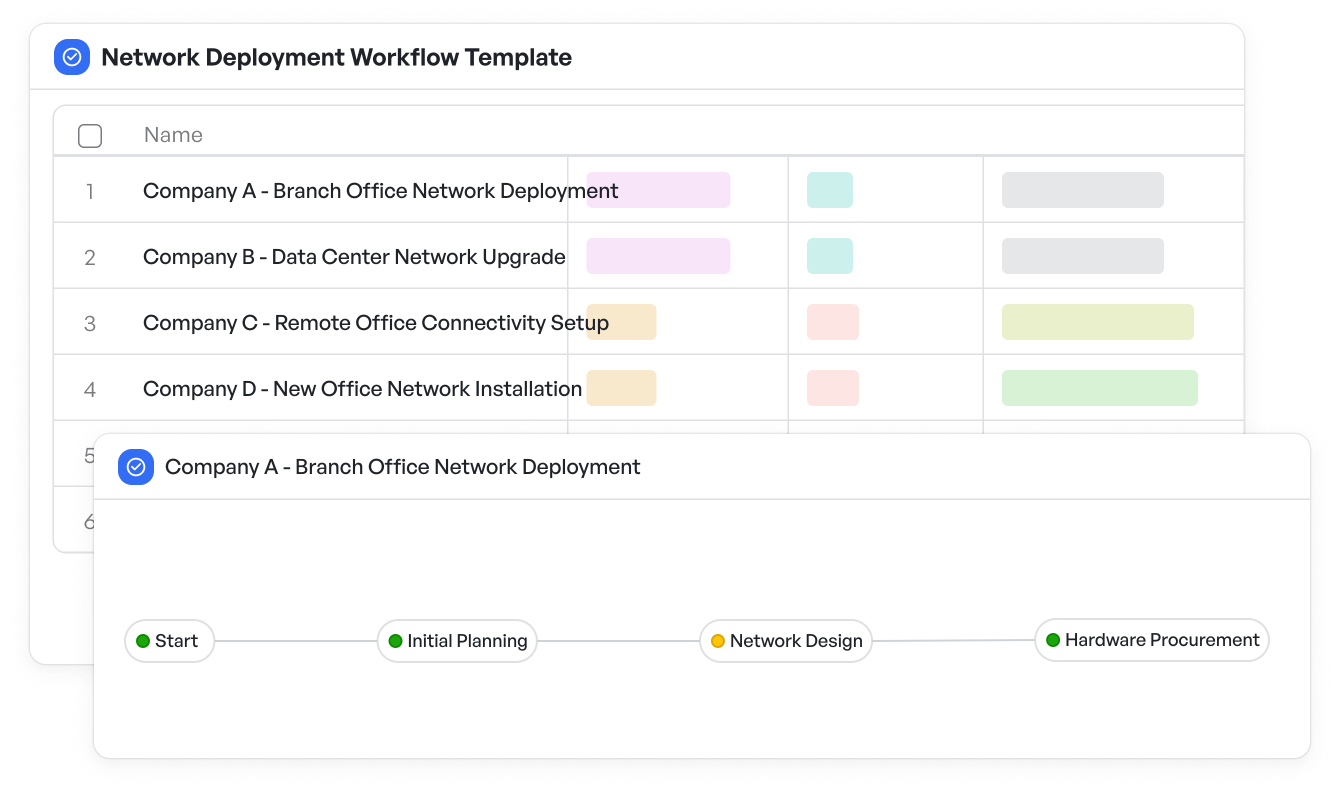 You might be interested in: Network deployment workflow template
You might be interested in: Network deployment workflow templateSupport Operations And Ticket Management
Support teams benefit from lean by adopting ticket triage systems, clear escalation paths, and real-time visibility into issue statuses. Using visual workflows can be pivotal in eliminating backlog and improving resolution times.
By optimizing escalation paths and leveraging workflow visualization, support teams can prioritize faster, resolve issues proactively, and maintain high service levels.
Lean Templates You Can Use Today:
- Telecom service activation workflow: Streamline provisioning across departments.
- Telecom network deployment schedule: Plan rollouts with zero bottlenecks.
- Telecom network project timeline: Reduce waste and maximize uptime.
- Telecom project risk mitigation: Build resilient operations with pre-modeled risk plans.
- Telecom project stakeholder engagement: Align internal and external teams in every phase.
Browse all 25+ Telecom Templates
Challenges In Implementing Lean In Telecommunications
Despite its advantages, implementing lean methodologies in the telecommunications sector presents several challenges.
- Cultural resistance to change: Teams used to traditional hierarchies may resist autonomy-based Lean workflows.
- Lack of cross-functional alignment: Lean requires shared KPIs and workflows, which can be tough in siloed environments.
- Tooling limitations: Legacy systems often lack flexibility for lean-friendly visual workflows.
To address these, enterprises must invest in modern software tools that allow flexibility, visualization, and team collaboration.
Driving a Culture of Continuous Improvement
For lean to succeed in telecommunications, leadership must:
- Encourage experimentation
- Celebrate process improvements
- Use data to guide retrospectives
- Integrate feedback loops into team rituals.
Lean is not a one-time project but a mindset. Telecom companies that integrate lean into their operations build stronger, faster, and more customer-aligned businesses.
To truly realize the benefits of lean, investing in the right tools that enable visibility, cross-functional collaboration, and continuous improvement is crucial. With the right software solutions in place, telecom teams can simplify complex processes, reduce waste, and scale operations efficiently.
Empowering Telecom Teams With Visual Workflows
One of the most effective enablers of lean in telecom is workflow visualization. Meegle’s visualized workflows provide a bird's eye view of task progress, ownership, and collaboration scope—essential in cross-functional, high-speed environments like telecom.
Every stakeholder starting from network engineers to project managers, can do the following:
- Instantly identify blockers
- Understand dependencies
- Track timelines and accountability
This is especially valuable in complex rollouts, compliance-heavy projects, or multi-vendor initiatives.
Suggested Read: Kanban in Telecommunication
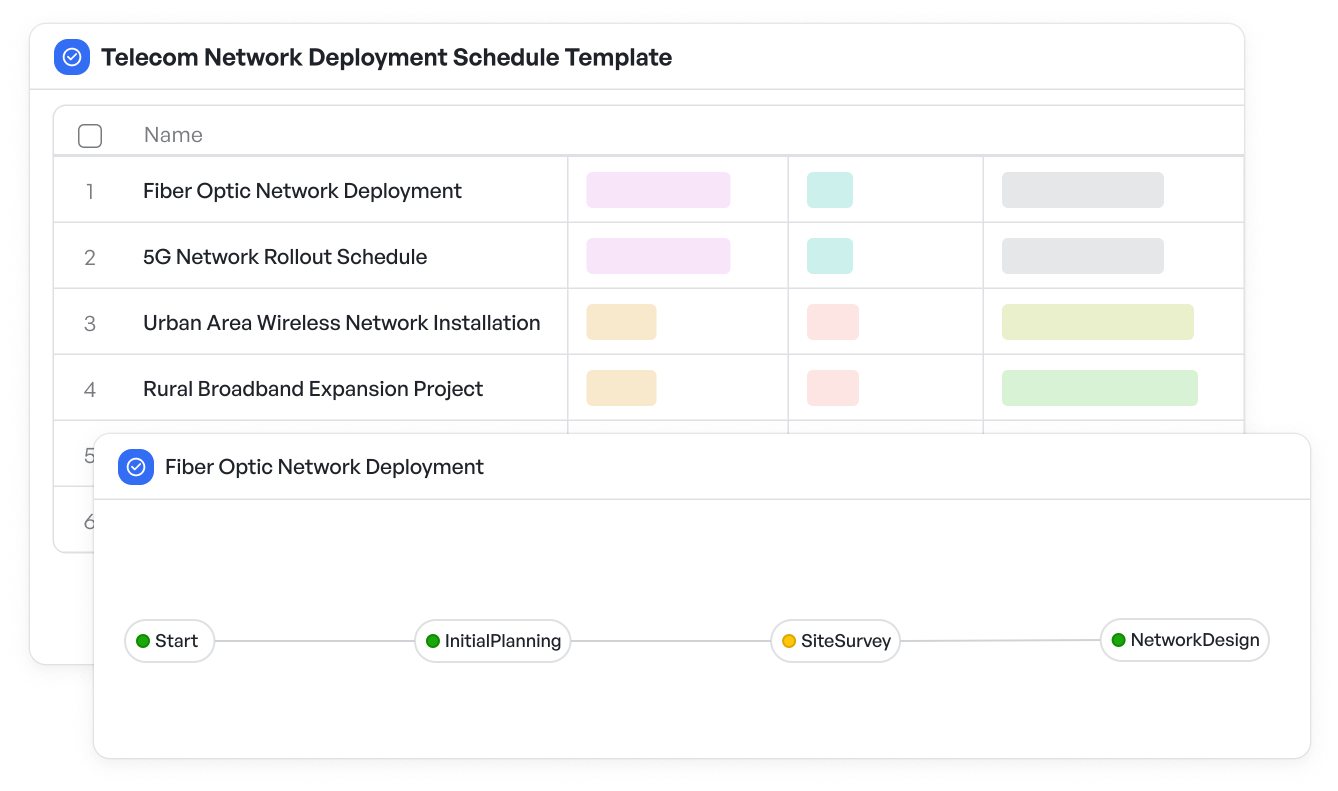 Meegle's Network deployment schedule template
Meegle's Network deployment schedule templateLean Is Not A One-Time Project
Lean is a mindset. It’s about seeing every process as an opportunity to improve. Telecom companies that integrate lean deeply into their DNA build stronger, faster, and more customer-aligned operations.
Unlock Efficiency, Standardization, And Scalable Growth With Lean In Telecommunications
If you're a telecom executive, project manager, or operations lead, lean can help you unlock efficiency, reduce cost, and scale effectively, without burning out your teams.
Achieve lean success in telecom with a visual workflow platform that balances complexity and simplicity by empowering teams to collaborate, adapt, and improve continuously.
Standardize and accelerate telecom transformation — Meegle makes lean execution easy.
The world’s #1 visualized project management tool
Powered by the next gen visual workflow engineRead More
Check All BlogsStart creating impactful work today



